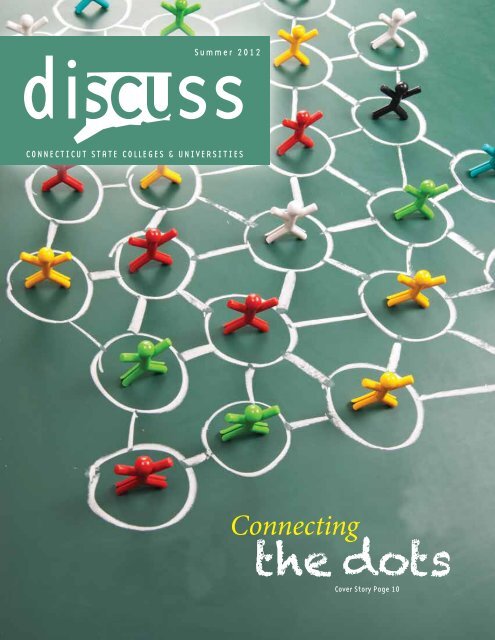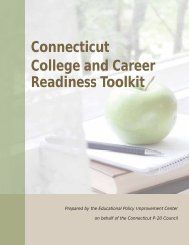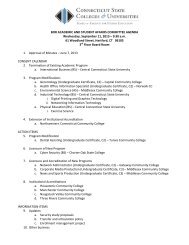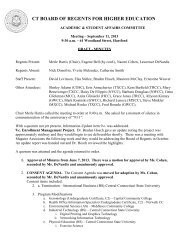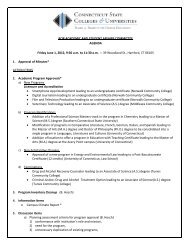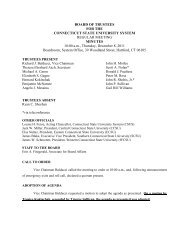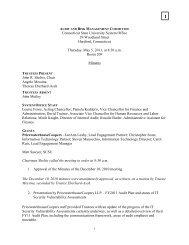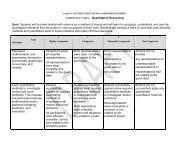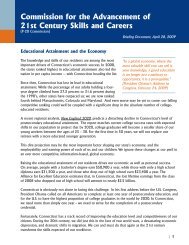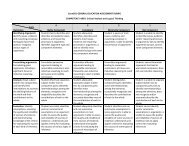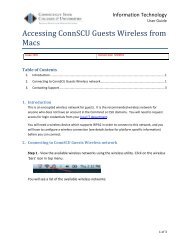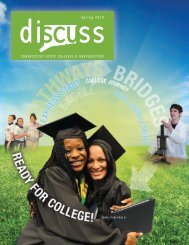Download (pdf) - Connecticut State Colleges & Universities
Download (pdf) - Connecticut State Colleges & Universities
Download (pdf) - Connecticut State Colleges & Universities
Create successful ePaper yourself
Turn your PDF publications into a flip-book with our unique Google optimized e-Paper software.
di<br />
Summer 2012<br />
ss<br />
<strong>Connecticut</strong> <strong>State</strong> <strong>Colleges</strong> & <strong>Universities</strong><br />
Connecting<br />
the dots<br />
Cover Story Page 10
Message from the Chairman and President of the Board of Regents<br />
It is our pleasure to introduce you to the first<br />
issue of diSCUss — the public affairs magazine<br />
dedicated to sharing some of the interesting<br />
stories and the latest news across the 17<br />
campuses of the <strong>Connecticut</strong> <strong>State</strong> <strong>Colleges</strong> &<br />
<strong>Universities</strong> (ConnSCU), governed by the Board<br />
of Regents for Higher Education.<br />
There is no question that each college and university within our<br />
new organization has a compelling story to share on its own. But<br />
together, as a statewide organization of 17 campuses offering the<br />
residents of <strong>Connecticut</strong> an affordable and accessible way to earn<br />
their degree or take part in career training and advancement, the<br />
story we have to tell is that much more powerful.<br />
With 96,000 students across our campuses, almost all of whom<br />
stay in <strong>Connecticut</strong> after graduation, it is clear the role our schools<br />
play in the workforce development of our state. The partnerships<br />
we can — and must — create between our community college<br />
and university campuses, as well as with the private sector and<br />
Charter Oak <strong>State</strong> College — the state’s only public, fully online,<br />
degree-granting institution — will help us all better understand<br />
what our state’s employers are looking for, and what we can do to<br />
better prepare the next generation of <strong>Connecticut</strong>’s workforce.<br />
We hope you enjoy the inaugural issue of diSCUss. Please visit<br />
www.ctregents.org to learn more about our schools, our<br />
campuses and our students.<br />
connecticut state colleges & <strong>Universities</strong><br />
B<br />
Eastern <strong>Connecticut</strong> <strong>State</strong> University graduates<br />
Photo by Nick Lacy<br />
Lewis J. Robinson<br />
Chairman, Board of Regents<br />
for Higher Education<br />
Robert A. Kennedy<br />
President, Board of Regents<br />
for Higher Education
<strong>Connecticut</strong> <strong>State</strong><br />
<strong>Colleges</strong> & <strong>Universities</strong><br />
diSCUss magazine<br />
Board of Regents<br />
Lewis J. Robinson, Jr., Chair<br />
Yvette Meléndez, Vice Chair<br />
Richard J. Balducci<br />
Naomi K. Cohen<br />
Lawrence DeNardis<br />
Nicholas M. Donofrio<br />
Matt Fleury<br />
Michael Fraser<br />
Merle W. Harris<br />
Gary F. Holloway<br />
Craig Lappen<br />
René Lerer<br />
Michael E. Pollard<br />
Alex Tettey Jr.<br />
Zac Zeitlin<br />
Ex-Officio Members<br />
Jewel Mullen, Commissioner<br />
Department of Public Health<br />
Dennis Murphy, Acting Commissioner<br />
Department of Labor<br />
Stefan Pryor, Commissioner<br />
Department of Education<br />
Catherine Smith, Commissioner<br />
Department of Economic and<br />
Community Development<br />
President<br />
Robert A. Kennedy<br />
diSCUss is published by<br />
the Office of Public Affairs<br />
and Marketing<br />
10<br />
2<br />
www.ctregents.org<br />
features<br />
di<br />
Summer 2012 Vol.1 No.1<br />
ss<br />
Cover Story<br />
Connecting the Dots pg. 10<br />
The consolidation of the four state universities, 12 community colleges<br />
and one online college into the 17 campuses of the <strong>Connecticut</strong> <strong>State</strong><br />
<strong>Colleges</strong> and <strong>Universities</strong> ConnSCU, governed by the Board of Regents for<br />
Higher Education, offers an accessible option to further student education.<br />
Manufacturing & Technology<br />
Manufacturing Centers pg. 2<br />
Three community colleges were selected for the creation of manufacturing<br />
centers to meet the state’s manufacturing workforce needs.<br />
Chief of Staff<br />
Director of Public Affairs<br />
and Marketing<br />
Colleen Flanagan<br />
Managing Editor<br />
Terri Raimondi<br />
Proofreading<br />
Patricia Mulcahy<br />
Web Communication and<br />
Design Coordinator<br />
Andrew Morris<br />
Staff and Contributors of<br />
Asnuntuck Community College, Capital<br />
Community College, Central <strong>Connecticut</strong><br />
<strong>State</strong> University, Charter Oak <strong>State</strong> College,<br />
Eastern <strong>Connecticut</strong> <strong>State</strong> University, Gateway<br />
Community College, Housatonic Community<br />
College, Manchester Community College,<br />
Middlesex Community College, Naugatuck<br />
Valley Community College, Northwestern<br />
<strong>Connecticut</strong> Community College, Norwalk<br />
Community College, Quinebaug Valley<br />
Community College, Southern <strong>Connecticut</strong><br />
<strong>State</strong> University, Three Rivers Community<br />
College, Tunxis Community College,<br />
Western <strong>Connecticut</strong> <strong>State</strong> University<br />
Design<br />
Allen Design Associates<br />
8<br />
14<br />
Health and Science<br />
New Health Information<br />
Management Major pg. 8<br />
The Board of Regents recently approved Charter Oak <strong>State</strong><br />
college’s first major — an online bachelor’s degree completion<br />
program in Health Information Management.<br />
EDucation news<br />
Gear Up Grant pg. 14<br />
The <strong>State</strong> of <strong>Connecticut</strong> was chosen by the U.S. Department of<br />
Education to receive Gaining Early Awareness and Readiness for<br />
Undergraduate Programs (GEAR UP) grant to help improve college<br />
access and readiness.<br />
departments<br />
Manufacturing & Technology pg. 2 Going Green pg. 15<br />
Community Connections pg. 6 Across ConnSCU pg. 16<br />
Health & Science pg. 8 Accolades pg. 18<br />
Education News pg. 14 Click pg. 20<br />
connecticut state colleges & <strong>Universities</strong><br />
1
manufacturing & technology<br />
Three Community<br />
<strong>Colleges</strong> Selected for New<br />
Manufacturing Centers ><br />
Housatonic Community College (HCC) in Bridgeport,<br />
Naugatuck Valley Community College (NVCC)<br />
in Waterbury and Quinebaug Valley Community<br />
College (QVCC) in Danielson were selected for<br />
the creation of manufacturing centers to meet the<br />
state’s workforce needs.<br />
The colleges were selected in response to the passage of<br />
Governor Dannel P. Malloy’s bipartisan Jobs Bill, which<br />
encouraged new job creation, while strengthening the<br />
state’s workforce competitiveness. “Having a workforce<br />
that is able to fill these jobs is vital to spurring economic<br />
growth, and these Manufacturing Centers will play a<br />
significant role in boosting those efforts,” said Malloy.<br />
Included in the bill is $17.8 million in state bond funding<br />
for the development of manufacturing programs at the<br />
three community colleges. This funding includes capital<br />
equipment purchases and the renovation and expansion<br />
of existing college facilities to accommodate a<br />
manufacturing center.<br />
Naugatuck Valley Community College’s Technology Hall.<br />
The proposal review committee included representatives<br />
from the Board of Regents for Higher Education (BOR), the<br />
Department of Economic and Community Development (DECD),<br />
the <strong>Connecticut</strong> Center for Advanced Technology (CCAT),<br />
the <strong>Connecticut</strong> Business and Industry Association (CBIA)<br />
Education Foundation and Asnuntuck Community College.<br />
The idea for the three new manufacturing centers was spurred<br />
by the success of Asnuntuck Community College’s successful<br />
Manufacturing Technology Center in Enfield. Also included in<br />
the Jobs Bill package is $2.2 million in bonding authorization<br />
to expand Asnuntuck’s precision manufacturing program.<br />
Manufacturing and Engineering Across ConnSCU<br />
connecticut state colleges & <strong>Universities</strong><br />
2<br />
>Engineering Programs to Expand<br />
As part of the concept to reallocate $5.5 million in central office<br />
savings to the campuses for tenure track faculty and direct<br />
student support services positions, the Board of Regents for<br />
Higher Education approved a proposal by Central <strong>Connecticut</strong><br />
<strong>State</strong> University (CCSU) to strengthen and expand their<br />
renowned engineering program, while at the same time, support<br />
the community college pipeline through which a number of their<br />
students progress.<br />
CCSU will receive funding for six new faculty positions for<br />
their engineering department and other related areas. But as a<br />
critical element to CCSU’s proposal, seven community colleges<br />
that have mechanical and/or advanced manufacturing<br />
engineering pathways will each receive funding for one<br />
position to teach and advise students who wish to earn<br />
their bachelor’s degree at CCSU.<br />
“This is exactly the kind of partnership that we need to<br />
support and expand across our campuses,” said BOR<br />
President Robert Kennedy. “Central President Jack Miller<br />
and his staff should be commended for thinking creatively,<br />
and involving the leaders of other campuses with whom<br />
they already work.”
The three community colleges will also be responsible for<br />
providing measurable outcomes — which include students<br />
graduating from the program and final job placement in the<br />
state’s manufacturing industry. Programs must meet the specific<br />
needs of the region’s manufacturing sector, offer a standard<br />
core curriculum and industry recognized credentials, which is a<br />
priority for the Dream It. Do It. initiative, led in <strong>Connecticut</strong> by<br />
CCAT and co-chaired by President Kennedy.<br />
Visit www.ctregents.org/manufacturing for more information<br />
“Manufacturing<br />
education programs<br />
that respond to the<br />
needs of the state’s<br />
manufacturers will<br />
prepare students<br />
for the 21st century<br />
global workforce.”<br />
- BOR President Robert Kennedy<br />
Photos by the Regional Center for Next Generation Manufacturing - A National Science Foundation Center of Excellence<br />
>The following community college<br />
campuses will each receive one<br />
position as part of CCSU’s proposal<br />
to expand its engineering program:<br />
>Asnuntuck Community College<br />
>Housatonic Community College<br />
>Manchester Community College<br />
>Naugatuck Valley Community College<br />
>Norwalk Community College<br />
>Quinebaug Valley Community College<br />
>Tunxis Community College<br />
connecticut state colleges & <strong>Universities</strong><br />
3
manufacturing & technology<br />
Manufacturing Centers:<br />
Students Wanted ><br />
NOW ENROLLING STUDENTS FOR FALL 2012<br />
The three new community college<br />
manufacturing centers at Housatonic Community<br />
College, Naugatuck Valley Community College<br />
and Quinebaug Valley Community College — in<br />
addition to the existing manufacturing center at<br />
Asnuntuck Community College — are currently<br />
enrolling students for the fall 2012 semester,<br />
with an expected Advanced Manufacturing<br />
Certificate completion date of May 2013.<br />
“If we’re going to increase job growth and<br />
remain competitive, we must be aware of how<br />
critically important it is for manufacturers to<br />
have access to employees with an advanced<br />
skill set,” said Governor Dannel P. Malloy.<br />
“Following the successful Asnuntuck model,<br />
More than 300 high school students attended a Pathways to Manufacturing and Engineering<br />
these three new manufacturing centers will Technology Careers Expo at Tunxis Community College.<br />
serve more students from across our state and<br />
ensure that they are ready to compete in the<br />
21st century global economy,” said Board of Regents President Robert A. Kennedy.<br />
Photo by <strong>Connecticut</strong> Business<br />
and Industry Association<br />
Students who earn their Machine Technology Level I Certificate will receive a primary level of skill in the machining area of<br />
manufacturing. The Advanced Manufacturing: Machine Technology Level II Certificate will provide additional skills in machine<br />
technology and Computer Numeric Control (CNC) manufacturing environments.<br />
These credits may be applied to the College of Technology’s (COT) Technology Studies Advanced Manufacturing degree option<br />
which may be used for seamless transfer to several four-year universities including Central <strong>Connecticut</strong> <strong>State</strong> University.<br />
Interested students can visit www.ctregents.org/manufacturing<br />
Manufacturing and Engineering Across ConnSCU<br />
connecticut state colleges & <strong>Universities</strong><br />
4<br />
Students examine a laser engraving and cutting system<br />
at Gateway Community College.<br />
Photo by <strong>Connecticut</strong> Business and Industry Association<br />
>Pathways to Manufacturing and Engineering Technology Careers<br />
Tunxis Community College and Gateway Community College held Pathways to Manufacturing and<br />
Engineering Technology Careers Expos that drew hundreds of high school students to campus.<br />
At Tunxis, the expo was sponsored by the <strong>Connecticut</strong> Community <strong>Colleges</strong>’ College of Technology’s<br />
Regional Center for Next Generation Manufacturing (RCNGM), a National Science Foundation Center of<br />
Excellence. The <strong>Connecticut</strong> Business and Industry’s (CBIA) Education Foundation coordinated the event.<br />
Students from 11 high schools attended demonstrations and workshops by more than 25 <strong>Connecticut</strong><br />
manufacturers on digital manufacturing, CNC machining, electric vehicle technology and jet engine design.<br />
Presentations were made by representatives from UTC Power, ebm-Papst, and GE Energy.<br />
Gateway also hosted high school students and parents from 10 high schools schools to educate them about<br />
careers in next-generation manufacturing and <strong>Connecticut</strong>’s growing manufacturing sector. The expo was<br />
offered by RCNGM with support from CBIA, the New Haven Manufacturers’ Association and other partners.
Initiative Seeks to Expand <strong>State</strong>’s Pool<br />
of ‘Dream’ Manufacturing Jobs ><br />
In President Barack Obama’s <strong>State</strong> of the Union speech, the<br />
president called for laying out a blueprint “for an economy<br />
that’s built to last — an economy built on American<br />
manufacturing, skills for American workers and a<br />
renewal of American values.”<br />
That sounds like something industry, higher education and government<br />
should support — but in practical application, how would that work?<br />
In <strong>Connecticut</strong>, we’ve started to tackle the issue. As co-chairs of<br />
<strong>Connecticut</strong>. Dream It. Do It., an initiative modeled after the<br />
Manufacturing Institute’s national effort to enhance the manufacturing<br />
workforce, we’re bringing together a coalition of business and industry<br />
associations, educational<br />
institutions, economic<br />
development organizations<br />
and manufacturers to enhance<br />
<strong>Connecticut</strong>’s manufacturing<br />
sector and create the next<br />
generation of skilled workers.<br />
Our message is loud and clear.<br />
It’s not your grandfather’s<br />
or even your father’s world of manufacturing anymore. Today’s<br />
manufacturing is high-tech, clean and cutting-edge. Jobs — and<br />
exciting careers — do exist and you can find them in manufacturing<br />
companies throughout the state. From making jets fly to building<br />
helicopters and submarines to creating life-saving biomedical devices<br />
to robotics, <strong>Connecticut</strong>’s advanced manufacturing industries compete<br />
worldwide and offer high-tech, rewarding career opportunities.<br />
But even in this economy, every day we hear from employers<br />
who can’t find enough skilled workers to fill existing jobs. The<br />
manufacturing workforce is graying and we must focus on filling the<br />
talent pipeline with the people who have the right skills and the right<br />
credentials for these high-tech jobs.<br />
The right credentials are a vital part of the solution. Credentialed<br />
individuals demonstrate that they have learned and practiced the skills<br />
needed to be successful in entry-level positions in any manufacturing<br />
company. The <strong>Connecticut</strong>. Dream It. Do It. initiative supports<br />
the use of the National Association of Manufacturers-Endorsed<br />
Skills Certification System to help increase the number of prepared<br />
applicants for manufacturing jobs. The system focuses on<br />
credentials that are nationally portable, third-party-validated, and<br />
industry-driven.<br />
We are also moving to close the skills gap, align manufacturing<br />
programs with future cutting-edge technologies, and step up<br />
training in our state. Last October, the state legislature passed<br />
Governor Dannel P. Malloy’s bipartisan Jobs Bill, which encourages<br />
new job creation while developing and strengthening the state’s<br />
workforce competitiveness. In response to the bill, three community<br />
colleges — Housatonic, Naugatuck Valley, and Quinebaug Valley<br />
— have been selected for the creation of manufacturing centers to<br />
meet the state’s workforce needs. The bill provides for $17.8 million<br />
in capital funding for the<br />
manufacturing centers, and<br />
$2.2 million to expand the<br />
<strong>Connecticut</strong>.<br />
Dream it. Do it.<br />
By Robert Kennedy, Glenn Marshall and Anthony Cacace<br />
precision manufacturing<br />
program at Asnuntuck<br />
Community College.<br />
Although state funding<br />
provides a foundation<br />
to address the need for<br />
skilled workers, building manufacturing centers alone won’t ensure<br />
success. We need to attract students to these centers. We need<br />
to educate students, families and educators to the challenging and<br />
rewarding opportunities of the manufacturing world. This is the<br />
talent pipeline we need to build.<br />
Let’s start by making <strong>Connecticut</strong>. Dream It. Do It. our rallying cry<br />
and push hard for federal support to buttress what we are able to do<br />
at the state level. We must maximize President Obama’s commitment<br />
to train two million workers through a streamlined workforce system<br />
built on partnerships with businesses. Federally funded training<br />
programs will enable us to build a highly-skilled, educated workforce<br />
that will make manufacturers more innovative, more productive, and<br />
more competitive. It’s what will drive our state’s economic recovery<br />
today and secure our prosperity in the future.<br />
Robert Kennedy is president of the state Board of Regents for Higher Education<br />
Glenn Marshall is former commissioner of the state Department of Labor; and<br />
Anthony Cacace is executive vice president of business development of GKN<br />
Aerospace Corp. in Cromwell. This article ran in the “Other Voices” section of the<br />
Hartford Business Journal on Feb. 27, 2012.<br />
connecticut state colleges & <strong>Universities</strong><br />
5
HIGH ST<br />
HAYNES S T<br />
community connections<br />
Workforce & Community Connections<br />
Isham-Terry<br />
House<br />
connecticut state colleges & <strong>Universities</strong><br />
Metro<br />
Center<br />
Building (IRS)<br />
6<br />
>Capital Community College<br />
and Hartford Stage<br />
Collaborate with “One Play”<br />
Hartford Stage and Capital Community College in Hartford<br />
have partnered through “One Play” to expose students to<br />
the theatre world.<br />
Tower<br />
49<br />
P P<br />
Exit 50<br />
L<br />
n<br />
HIGH ST<br />
P<br />
P<br />
P<br />
7<br />
Homewood<br />
Suites<br />
P<br />
F O R D S T<br />
ALLYN ST<br />
9<br />
6 P<br />
A S Y L U M S T<br />
P<br />
P<br />
CELLO ST ANN UCCELLO ST<br />
Hartford 21 P<br />
“One Play,” which began in 2011, focuses on a single<br />
Hartford Stage play and offers lectures, panel discussions<br />
with actors and professional development<br />
opportunities for faculty. Many instructors<br />
include the play in their courses and<br />
Hartford Stage offers Capital Community<br />
College nights.<br />
Last fall more than 400 from Capital<br />
attended the first “One Play” — Water<br />
by the Spoonful — about a Latino family<br />
in contemporary America; and this spring,<br />
more than 500 attended The Whipping<br />
Man, about a Jewish Confederate soldier<br />
and two former slaves raised as Jews in<br />
his household after the Civil War.<br />
The initiative grew out of a National<br />
Endowment for the Humanities grant<br />
spearheaded by Jeffrey Partridge,<br />
Capital’s chair of Humanities. The grant provides the college’s<br />
Humanities faculty with the opportunity to study Hartford’s history,<br />
literature, communities and culture by interacting with scholars at<br />
CHAPEL ST NORTH<br />
P<br />
area<br />
Keney Clock<br />
institutions to engage students.<br />
CHAPEL ST SOUTH<br />
P<br />
Hartford<br />
Hilton<br />
C H U R C H S T<br />
P<br />
XL Center<br />
YMCA<br />
City<br />
Place<br />
P E A R L S T<br />
TheaterWorks<br />
5<br />
P<br />
TRUMBULL S T<br />
TRUMBULL<br />
S T<br />
Rensselear<br />
at Hartford<br />
Hartford<br />
Stage<br />
Company<br />
4<br />
HARTFORD<br />
STAGE<br />
COMPANY<br />
10 11<br />
Welcome Center<br />
Visitor Information<br />
IS ST<br />
PRATT ST<br />
100 Pearl<br />
M A I N S T<br />
P<br />
P<br />
P<br />
Gold Building<br />
(One Financial<br />
Plaza)<br />
12<br />
20 Church<br />
Street<br />
P<br />
I N S T<br />
San Juan Sport Center’s<br />
Jeffrey Dressler Arena<br />
Crowne<br />
Plaza<br />
N. MORGAN ST<br />
P<br />
Capital Community<br />
College<br />
Residence Inn<br />
Old <strong>State</strong><br />
House<br />
MORGAN ST<br />
TALCOTT ST<br />
TEMPLE ST<br />
<strong>State</strong> House Square<br />
CENTRAL ROW<br />
13<br />
P<br />
P<br />
Bus<br />
Kiosk<br />
P<br />
P<br />
P<br />
M A R K E T S T<br />
AMERICAN<br />
ROW<br />
Dodge Music<br />
Center<br />
P<br />
Exit 51<br />
P<br />
P<br />
UCONN School<br />
of Business<br />
Constitution Plaza<br />
P<br />
P<br />
P<br />
Phoenix Boat<br />
Building<br />
14<br />
15<br />
STATE<br />
KINSLEY<br />
P<br />
ST<br />
Mortensen<br />
Riverfront Plaza<br />
<strong>Connecticut</strong><br />
Science<br />
Center<br />
(Spring 2009)<br />
Riverside<br />
Park<br />
Riverwalk<br />
Bulkeley Bridge<br />
C o n n e c t i c u t<br />
Rentschler Field<br />
Stadium<br />
Founders Bridge<br />
Performance<br />
Tent<br />
Lady<br />
Katharine<br />
Cruises<br />
er Park<br />
>One Book, One Community<br />
The fifth annual One<br />
Book, One Community<br />
project — a partnership<br />
of Western <strong>Connecticut</strong><br />
<strong>State</strong> University<br />
(WCSU), Danbury<br />
Library, Danbury public<br />
schools and Wooster<br />
School — recently<br />
kicked off with the selection<br />
of Breakfast with Buddha by Roland Merullo.<br />
Each year, organizers plan events and readings<br />
around the theme of the selected book. This<br />
year, the book dovetails with the October visit<br />
of the Dalai Lama, the spiritual leader of the<br />
Tibetan people, to WCSU.<br />
WCSU President James Schmotter said the<br />
program has been good for bringing together<br />
many levels of the Danbury community. “It<br />
shows how we can come together to<br />
make Danbury a more vibrant, aware, and<br />
intellectual place,” he said.<br />
>Manchester Community College<br />
Partners with Hartford Public Schools<br />
at Great Path Academy<br />
Manchester Community College (MCC) President<br />
Gena Glickman and Hartford Public Schools<br />
Superintendent Christina M. Kishimoto held<br />
a signing ceremony to mark the five-year<br />
agreement under which Hartford Public Schools<br />
will be managing Great Path Academy, MCC’s<br />
middle college high school.<br />
President Glickman and Superintendent<br />
Kishimoto were joined by Matthew K. Poland,<br />
chair of the Hartford Board of Education,<br />
Deputy Mayor Jay Moran of Manchester and<br />
Dr. G. Duncan Harris, Dean of Student Affairs<br />
at Manchester Community College.<br />
(Left to right, seated): MCC President Gena Glickman; Superintendent<br />
Christina Kishimoto, Hartford Public Schools; (left to right, standing): Regina<br />
Ferrante, MCC; G. Duncan Harris, MCC dean of Student Affairs; Dianna<br />
Roberge-Wentzell and Alexander Nardone, Hartford Public Schools.
across the universities & <strong>Colleges</strong><br />
>Bridgeport Early College Partnership<br />
Housatonic Community College, The University<br />
of Bridgeport, Fairfield University and Sacred<br />
Heart University are taking part in the Bridgeport<br />
Early College Program. The program — part<br />
of the city-wide school reform effort —<br />
allows Bridgeport high school students to<br />
experience college before they graduate<br />
from high school.<br />
High School seniors who meet the academic<br />
requirements will be able to take college classes<br />
for dual credit. In order to qualify for the early<br />
college program in their senior year, as a junior<br />
students must have at least a C average, be in<br />
good standing and pass a special test.<br />
Work Hub at Eastern><br />
S<br />
even Eastern <strong>Connecticut</strong> <strong>State</strong> University students — majoring in<br />
Business Information Systems, Mathematics and Computer Science —<br />
have learned valuable skills at an on-campus “Work Hub” that opened<br />
last fall. Several students were even offered jobs before graduation.<br />
The hub, housed in Winthrop Hall, offers workspace for student interns<br />
who can work remotely for businesses and features separate offices,<br />
computer terminals, technology and mentors. In the “Work Hub,” students<br />
literally “go to work” for private and public sector organizations.<br />
Bloomfield-based insurance company Cigna was their first client, and hired<br />
12 students to work on web development and information technology<br />
projects. The ECSU Foundation, Inc. also funded a new computer system,<br />
furniture and office renovations.<br />
>NVCC Partners with AmeriCorps to<br />
Make a Difference<br />
Waterbury AmeriCorps is a mentoring program<br />
in which volunteers work directly with “at-risk”<br />
middle school students in the Waterbury Public<br />
School system. John Corcoran, the program’s<br />
coordinator who helped launch the partnership<br />
between the city of Waterbury and Naugatuck<br />
Valley Community College (NVCC), said the<br />
group of 35 community advocates is close to<br />
reaching full-swing after receiving its initial<br />
funding from the Corporation for National and<br />
Community Service in 2011.<br />
Volunteers include students from NVCC and<br />
UConn Waterbury, along with community<br />
members who volunteer at the Boys and Girls<br />
Club, Girls Inc., Family Services of Greater<br />
Waterbury, Salvation Army, city schools and the<br />
Children’s Community School.<br />
AmeriCorps members recently constructed<br />
raised garden beds for the South End<br />
Neighborhood Association to grow a<br />
supplemental food supply, which will help<br />
provide 12 low-income families with their own<br />
produce throughout the summer.<br />
“My goal is to get companies to outsource to Eastern,<br />
not to India. All Eastern students are required to<br />
have some kind of pre-professional experience before<br />
graduation, whether it’s through an internship,<br />
cooperative work experience, community service,<br />
or research. The goal is to provide a well-rounded<br />
education — a liberal education that’s practically<br />
applied.” - Eastern President Elsa Núñez<br />
Photo by Nick Lacy<br />
connecticut state colleges & <strong>Universities</strong><br />
7
health & science<br />
New Health Information<br />
Management Major at<br />
Charter Oak <strong>State</strong> College><br />
The Board of Regents recently approved Charter Oak <strong>State</strong><br />
College’s first major — an online bachelor’s degree completion<br />
program in Health Information Management. The program<br />
now goes to the New England Association of Schools and<br />
<strong>Colleges</strong> (NEASC) for approval.<br />
The B.S. in Health Information Management prepares<br />
graduates to sit for the RHIA (Registered Health Information<br />
Administrator) licensure exam. Charter Oak plans to offer<br />
courses in late October.<br />
Students will graduate from this online program equipped<br />
with the skills to develop, maintain and enforce organizational<br />
policies, procedures and guidelines for the management<br />
of health information and health information technology<br />
systems. They will manage, modify and purge healthcare<br />
data in accordance with organizational policies and statespecific<br />
Statute of Limitations. The curriculum — developed in<br />
response to a growing demand in the field — includes coding<br />
schemes for reimbursement of healthcare services.<br />
Visit www.charteroak.edu for more information about<br />
this new program<br />
“We chose to make this<br />
program our highest priority<br />
because we believe that<br />
there are, and will continue<br />
to be, numerous jobs that<br />
will require the combination<br />
of healthcare knowledge<br />
and technology expertise<br />
as the healthcare industry<br />
moves its patient data into<br />
digital systems that permit<br />
customers access to their<br />
own information.”<br />
- Ed Klonoski, Charter Oak <strong>State</strong> College President<br />
Health & Science across the <strong>Colleges</strong> and <strong>Universities</strong><br />
connecticut state colleges & <strong>Universities</strong><br />
8<br />
>Grant Helps WCSU Professor with Lyme Disease Study<br />
Neeta Connally, assistant professor of biological and environmental sciences at Western<br />
<strong>Connecticut</strong> <strong>State</strong> University (WCSU), received a $35,000 grant from the state Department of<br />
Health to help her hire students to conduct a tick prevention study in several area towns.<br />
Connally, a former Yale research scientist and expert on Lyme disease, has establishing a<br />
research program at the university on the ecology of the deer tick and disease prevention in<br />
collaboration with the Centers for Disease Control, Yale School of Public Health and the the<br />
state Department of Health.<br />
The Ridgefield Health Department partnered with Connally to assess the risk for tick-borne<br />
illnesses at Ridgefield public recreation areas. A “Tick SWAT Team,” composed primarily of<br />
WCSU biology students, has been conducting timed “tick drags” at local public schools and<br />
sports fields to monitor tick density and evaluate habitat.<br />
Western Biology student Jillian Gioia<br />
drags for ticks in Ridgefield
New Allied Health Labs Coming to Gateway<br />
Gateway Community College will open two new Allied Health labs at its<br />
new downtown campus this fall — a Nuclear Medicine Technology (NMT)<br />
Lab and a new Computerized Tomography (CT) Lab.<br />
The NMT Laboratory will allow students to practice imaging procedures<br />
and radiation safety techniques using the newest technology, including<br />
the high-tech gamma camera and radiation detection instruments. The<br />
gamma camera produces two- and three-dimensional images of patients’<br />
internal organs. The lab also will include uptake probes, dose calibrators,<br />
well and Geiger counters. NMT students will join radiography and radiation<br />
therapy students in using a new CT<br />
Laboratory featuring a refurbished<br />
Siemens Somatom Emotion CT<br />
unit that will allow students to<br />
simulate basic CT procedures using<br />
“phantom” body parts.<br />
> Northwestern Graduates First Nurses<br />
Northwestern <strong>Connecticut</strong> Community College graduated its first<br />
class of nurses in May. There were 19 nursing graduates in the accelerated<br />
program who received degrees and were given pins in a separate ceremony.<br />
The commencement’s keynote speaker was U.S. Rep. John B. Larson, D-1st<br />
District, who was instrumental in securing $350,000 in federal funds to<br />
design and equip a high-tech nursing lab at the college.<br />
Health & Science across the universities & <strong>Colleges</strong><br />
Capital Launches Health IT Internship ><br />
C<br />
apital Community College has collaborated with<br />
<strong>Connecticut</strong>’s leading health care organizations to<br />
develop Health Information Technology (Health IT)<br />
student internship and job opportunities to train<br />
the workforce to meet the state’s Health IT needs.<br />
Health IT is the computerized management of<br />
health records with an an aim to improve health care<br />
quality for 300 million U.S. residents by preventing errors,<br />
reducing costs, decreasing paperwork and providing<br />
real-time health records at the point of care. The aim is<br />
Photo by Julie Bidwell<br />
to improve health care quality by preventing errors, reducing<br />
costs, decreasing paperwork and providing real-time health<br />
records at the point of care.<br />
In <strong>Connecticut</strong>, the nationally developed training takes place<br />
exclusively at Capital where 108 people have successfully<br />
completed the six-month curriculum since 2011, with 50 more<br />
recently finishing the program. Students enrolled in Capital’s<br />
Health IT Workforce Training Program follow the Health IT<br />
consultant or Health IT engineer track.<br />
Federal funding for this program comes from the 2009<br />
American Recovery and Reinvestment Act (ARRA) to train a<br />
workforce that supports the implementation and maintenance<br />
of electronic health records (EHRs) for physicians, health<br />
centers and hospitals nationwide.<br />
Capital’s Health IT training program has been recognized by<br />
the Office of the National Coordinator for Health Information<br />
Technology. Partners include the Health Information<br />
Technology Exchange of <strong>Connecticut</strong> (HITE-CT), e-Health<br />
<strong>Connecticut</strong>, UConn, Hartford HealthCare, St. Francis<br />
Hospital and Medical Center, Capital Workforce Partners, the<br />
Community Health Care Association of <strong>Connecticut</strong>, the Center<br />
for Medicare and Medicaid Services and the <strong>Connecticut</strong><br />
Departments of Health and Social Services, among others.<br />
connecticut state colleges & <strong>Universities</strong><br />
9
cover story<br />
Connecting<br />
the dots<br />
connecticut state colleges & <strong>Universities</strong><br />
10<br />
Since arriving in <strong>Connecticut</strong> last September to<br />
lead the newly consolidated Board of Regents for<br />
Higher Education, President Robert A. Kennedy has<br />
travelled from one end of the state to the other —<br />
from the “Gold Coast” to the “Quiet Corner” and<br />
everywhere in between — and one thing is clear,<br />
<strong>Connecticut</strong>’s Board of Regents institutions — 17<br />
<strong>Connecticut</strong> <strong>State</strong> <strong>Colleges</strong> & <strong>Universities</strong><br />
— are just as vibrant, collaborative<br />
and energetic as ever. “But instead<br />
of stifling growth and creative,<br />
out-of-the-box thinking in our new,<br />
significantly larger organization, the<br />
consolidation seems to have people<br />
thinking more about partnerships and<br />
collaborative activities than ever before. There’s<br />
a sense that we’re ‘in this together’ and the future<br />
of our state’s workforce and economy lies in our<br />
collective hands,” said President Kennedy.<br />
“Understandably, there was a great deal of anxiety<br />
associated with the higher education consolidation<br />
proposed by Governor Malloy in 2011,” said Chairman of<br />
the Board of Regents Lewis J. Robinson. “Change is never<br />
easy, and many people were concerned<br />
that the community colleges would<br />
lose their identity, or the state<br />
universities would lose their<br />
independence. But now, a little<br />
more than six months after<br />
the consolidation officially<br />
occurred, I think people have a better sense of how this is all<br />
coming together, and they’re ready, willing and able to address<br />
a number of the issues that have stymied our state over the<br />
course of the last few decades in a way that just wasn’t<br />
possible before.”<br />
Prior to the consolidation, there were five separate boards<br />
for public higher education management in the state — the<br />
University of <strong>Connecticut</strong> Board of Trustees; the Board of<br />
Trustees for the Community College System; the Board of<br />
Trustees for the <strong>Connecticut</strong> <strong>State</strong> University System; the Board<br />
for <strong>State</strong> Academic Awards for Charter Oak <strong>State</strong> College, the<br />
state’s only fully online, public, degree-granting institution; and<br />
the Board of Governors for Higher Education. Governor Malloy’s<br />
plan — which was approved by the legislature in the spring<br />
of 2011 — created one Board of Regents for Higher Education<br />
”There’s a sense that ‘we’re<br />
in this together’ and<br />
the future of our state’s<br />
workforce and economy<br />
lies in our collective<br />
hands.”<br />
- BOR President Robert Kennedy.
charged with governing the four state universities, 12<br />
community colleges and Charter Oak <strong>State</strong> College. The<br />
plan also eliminated the Department of Higher Education<br />
and its Board of Governors for Higher Education.<br />
Following the Minnesota model, <strong>Connecticut</strong>’s land<br />
grant university, the University of <strong>Connecticut</strong>, remained<br />
separate and apart from the consolidation.<br />
When he proposed the consolidation, Governor Malloy<br />
was clear that while escalating spending at the central<br />
offices, to the detriment of on-campus instruction, was a<br />
central reason for this proposal, it was by no means<br />
the only one.<br />
“The facts are clear: every state is<br />
growing in the percentage of adults<br />
with degrees, but <strong>Connecticut</strong>’s rate<br />
of increase for young adults has<br />
dropped to 34th out of 50 states,”<br />
said Governor Malloy. “Tuition has<br />
increased, and the time it takes to earn<br />
a degree at these institutions exceeds the<br />
traditional four- or two-year curriculum. We<br />
need to make sure we’re preparing our young men and<br />
women to have a competitive edge and at the moment,<br />
we’re not doing a good enough job.”<br />
When the Board of Regents took over the sole responsibility<br />
for governing the 17 <strong>Connecticut</strong> <strong>State</strong> <strong>Colleges</strong> &<br />
<strong>Universities</strong> within the newly-combined organization<br />
on Jan. 1, 2012, President Kennedy and his staff began<br />
working to consolidate the central office operations of the<br />
state universities and community colleges. Those savings<br />
— $5.5 million — will be redirected to the campuses for<br />
tenure track faculty and direct student support services,<br />
such as counselors or advisors.<br />
“It’s never easy to talk about eliminating positions – the<br />
people who fill them have families to support and lives<br />
to lead,” said President Kennedy. “But I also<br />
couldn’t, with a clear conscience, combine<br />
the two operations together as one and<br />
keep the same number of people, while<br />
the campuses are desperate to add more<br />
professors and counselors.”<br />
In addition to merging the central offices<br />
into one more streamlined and efficient<br />
operation, having one board responsible for<br />
the academic policies and procedures for the<br />
organization as a whole has provided an opportunity to<br />
address — and fix — some of the problems that have<br />
stymied <strong>Connecticut</strong>’s higher education community for<br />
years: a seamless transfer policy across the community<br />
<strong>Connecticut</strong> <strong>State</strong> <strong>Colleges</strong> & <strong>Universities</strong><br />
Asnuntuck Community College, Enfield<br />
Northwestern CT Community College, Winsted<br />
Capital Community College, Hartford<br />
Tunxis Community College, Farmington<br />
Naugatuck Valley Community College, Waterbury<br />
Charter Oak <strong>State</strong> College (online)<br />
Western <strong>Connecticut</strong> <strong>State</strong> University, Danbury<br />
Housatonic Community College, Bridgeport<br />
Norwalk Community College, Norwalk<br />
Manchester Community College, Manchester<br />
Quinebaug Valley Community College, Danielson<br />
Central <strong>Connecticut</strong> <strong>State</strong> University, New Britain<br />
Eastern <strong>Connecticut</strong> <strong>State</strong> University, Willimantic<br />
Three Rivers Community College, Norwich<br />
Middlesex Community College, Middletown<br />
Gateway Community College, New Haven<br />
Southern <strong>Connecticut</strong> <strong>State</strong> University, New Haven<br />
connecticut state colleges & <strong>Universities</strong><br />
11
cover story<br />
colleges and state universities and rethinking remedial<br />
education — helping students who arrive at college<br />
unprepared to face the rigors of higher education.<br />
“When I went to work at the Department of Higher<br />
Education in 1978, a workable seamless transfer policy<br />
was the issue upon which everyone was focused,”<br />
said Dr. Merle Harris, chairwoman of the<br />
board’s Academic and Student Affairs<br />
Committee.<br />
Thirty-four years later, with strong<br />
help, support and guidance<br />
from the board’s Faculty<br />
Advisory Committee and<br />
Student Advisory Committee<br />
and leadership on the campuses,<br />
the Board of Regents passed a<br />
Transfer and Articulation Proposal<br />
with an aggressive timeframe and a<br />
high bar.<br />
“This is a tremendously complex issue to tackle, but you<br />
don’t hear a single person say we shouldn’t try,” said Board<br />
of Regents Vice President for <strong>State</strong> <strong>Universities</strong> Dr. Elsa<br />
Núñez, who is also president of Eastern <strong>Connecticut</strong> <strong>State</strong><br />
University. “I see students all the time who come to Eastern<br />
and expect their credits to transfer and a number of them<br />
do not. They’re spending time, money and effort to obtain<br />
credits that do nothing to help them graduate faster with<br />
their degree. We’re finally in a place where we can get in a<br />
room and hash this out and that’s exactly what’s happening.<br />
The faculty deserves an incredible amount of thanks for<br />
helping us to refine the proposal, and now, implement it.”<br />
In the 2012 legislative session, the General Assembly tackled<br />
the issue of remedial education. According to the Board of<br />
Regents Department of Policy and Research, just 13.6 percent<br />
of full-time students taking remedial courses actually earn<br />
an associate’s degree in four years, which is double the<br />
time it should take to earn this degree. While it’s true many<br />
community college students balance school with work and<br />
family obligations, which may limit the number of courses they<br />
can take in a semester, more must be done to expeditiously help<br />
community college students finish their degree. Dr. Núñez and<br />
Dr. David Levinson, vice president for Community <strong>Colleges</strong> and<br />
president of Norwalk Community College, have begun working<br />
on the issue with a cabinet of fellow presidents convened by<br />
President Kennedy.<br />
“No one disagrees this is a significant problem that spans<br />
the full P-20 educational spectrum,” said Dr. Levinson. “But<br />
the question is, what can we do to fix this? It’s encouraging<br />
to see the <strong>State</strong> Department of Education collaborate with<br />
the Board of Regents on the Common Core Curriculum, but in<br />
the meantime, we have a very short amount of time to figure<br />
out a way to help get our students up to<br />
speed when they come to our door,<br />
without exhausting their financial<br />
aid. It’s a tough question, but<br />
I’m heartened to see our<br />
state have the courage to<br />
acknowledge it<br />
in a meaningful way.”<br />
In addition to the academic<br />
issues the Board of Regents is<br />
addressing, workforce development and<br />
connecticut state colleges & <strong>Universities</strong><br />
12<br />
“Launching three new manufacturing centers across<br />
the state has been one of top priorities, and it<br />
underscores our commitment to being responsive to<br />
and partners with the state’s private sector.”<br />
- Board of Regents Executive Vice President Michael P. Meotti
connecting the seventeen schools<br />
to the state’s employers and private<br />
sector is also a key component of the<br />
consolidation.<br />
“Overwhelmingly, our 96,000 students across the system<br />
are from <strong>Connecticut</strong>, and they stay in <strong>Connecticut</strong> after<br />
graduation,” said President Kennedy. “If we don’t know<br />
what employers are looking for in their future hires, how<br />
can we make sure we’re training them properly?”<br />
To that end, President Kennedy and Board of Regents<br />
members — many of whom represent various sectors of<br />
<strong>Connecticut</strong>’s economy, as well as ex-officio members,<br />
Catherine Smith, the state’s commissioner of the<br />
Department of Economic and Community Development,<br />
and Dennis Murphy, the state’s acting commissioner of<br />
the Department of Labor — have sent a message to the<br />
state’s chambers, private industry, start-ups and other<br />
entrepreneurial ventures that ConnSCU institutions are<br />
ready, willing and able to partner with them on internships,<br />
co-ops, workforce training and certification.<br />
“Launching three new manufacturing centers across the<br />
state has been one of our top priorities, and it underscores<br />
our commitment to being responsive to and partners with<br />
the state’s private sector,” said Board of Regents Executive<br />
Vice President Michael P. Meotti.<br />
In addition, President Kennedy has been a fixture at<br />
Chamber of Commerce events across the state, and meets<br />
with private industry and trade groups often to discuss<br />
the ways in which ConnSCU institutions and the Board of<br />
Regents can have a seat at the table.<br />
It is clear there are no easy answers, and all that needs<br />
to be done will require partnership, teamwork, and<br />
approaching old problems with new frames of mind.<br />
“We know what our strengths are, and we know<br />
where our weaknesses lie,” said President Kennedy.<br />
“It’s incumbent upon us to address the weaknesses<br />
and build upon the strengths. More than any other<br />
state in which I’ve worked, <strong>Connecticut</strong> has all the<br />
right parts. We just need to connect the dots.”<br />
Board of Regents for Higher Education<br />
On June 21, 2012, the Board of<br />
Regents for Higher Education<br />
approved a concept for the<br />
reallocation of central office funding<br />
— totaling $5.5 million — back to the<br />
campuses for tenure track faculty<br />
and direct student support services<br />
positions across the 17 campuses.<br />
The funding will be used for<br />
anywhere between 40-45 new<br />
positions in already identified areas<br />
of expertise and those which support<br />
the state’s workforce development<br />
objectives, including manufacturing,<br />
bioinformatics/genetics, business,<br />
and science, technology, engineering<br />
and math (STEM) disciplines.<br />
Importantly, funding for five to ten<br />
of those positions will be devoted<br />
to those campuses which propose<br />
to use the positions to increase<br />
collaborative activity or build<br />
programmatic relationships across<br />
campuses.<br />
connecticut state colleges & <strong>Universities</strong><br />
13
education news<br />
<strong>State</strong> Wins Innovative<br />
Gear Up Grant ><br />
TWill Support College Access, Readiness<br />
he <strong>State</strong> of <strong>Connecticut</strong> was chosen by the U.S.<br />
Department of Education to receive a sevenyear,<br />
$31.5 million Gaining Early Awareness and<br />
Readiness for Undergraduate Programs (GEAR UP)<br />
grant to help improve college access and readiness<br />
for <strong>Connecticut</strong>’s students.<br />
“We need to better understand and break down the<br />
barriers <strong>Connecticut</strong>’s students face when they are<br />
preparing for higher education,” said <strong>Connecticut</strong> Governor<br />
Dannel P. Malloy. “Access to higher education is critical<br />
not only for these students’ own future personal success,<br />
but for <strong>Connecticut</strong>’s future economic success as well.”<br />
The funding will be used to significantly increase the<br />
number of low-income students prepared to enter and<br />
succeed in post-secondary education, and to provide<br />
scholarships for eligible high school seniors. The<br />
<strong>Connecticut</strong> state GEAR UP project will serve 3,000<br />
students attending 12 middle schools in East Hartford,<br />
New Haven and Waterbury through 2019, and will follow<br />
these students though middle school, high school and their<br />
first year of college.<br />
Governor Dannel P. Malloy held a press event at Naugatuck Valley Community<br />
College to announce state GEAR UP funding awards.<br />
GEAR UP in <strong>Connecticut</strong> is a partnership between the<br />
<strong>Connecticut</strong> Board of Regents for Higher Education (BOR),<br />
Manchester Community College (MCC), Naugatuck Valley<br />
Community College (NVCC) and Southern <strong>Connecticut</strong> <strong>State</strong><br />
University (SCSU) — and their local school districts. The<br />
colleges and universities, collaborating with the local school<br />
districts, will develop, provide and evaluate services to<br />
students, parents and teachers in order to fit localized needs<br />
and specific provider strengths.<br />
“Innovative GEAR UP programs that intervene early give<br />
students the opportunity to determine if they are ready for<br />
college and can make all the difference in whether they<br />
attend college,” said BOR President Robert A. Kennedy.<br />
“These grants provide the mentoring and support that<br />
gives thousands of students a chance to achieve academic<br />
success in postsecondary education.”<br />
connecticut state colleges & <strong>Universities</strong><br />
14<br />
(Left to right) SCSU President Mary Papazian, NVCC President Daisy Cocco<br />
De Filippis, BOR President Robert Kennedy, and MCC President Gena<br />
Glickman at the GEAR UP press event.
going green<br />
>NCC Students Power Up<br />
Students in Norwalk Community College’s<br />
(NCC) (BEST) Building Efficiency and<br />
Sustainable Technology) program and in NCC’s<br />
environmental science course worked together<br />
with solar installers from Elektron Solar of<br />
Westport to install “Off-Grid” power to NCC’s<br />
new “Building Science Shed.”<br />
The Off-Grid Solar Photovoltaic System will<br />
provide electrical power to the Shed and to a<br />
new irrigation system for an organic garden<br />
and compost bed. NCC’s organic vegetable<br />
gardens are used as teaching laboratories<br />
for NCC’s Biology and Environmental courses<br />
and provide fresh, organic produce for NCC’s<br />
Culinary Arts Program. The solar array was<br />
made possible by Innovation and Excellence<br />
funding from the Norwalk Community College<br />
Foundation. ▼<br />
(Left to right, front row) Eric Gribin, BEST Program coordinator; and<br />
BEST students Nivedita Gopalakrishan, Krystal Sayles, and Radu<br />
Tarta (Back row) NCC alumna Danielle Jablonski and David Clark<br />
>The Princeton Review Names<br />
Central and Eastern Green <strong>Colleges</strong><br />
For the third year in a row, Central and Eastern <strong>Connecticut</strong> <strong>State</strong><br />
<strong>Universities</strong> were named among the nation’s Green <strong>Colleges</strong> for<br />
2012 by the prestigious Princeton Review and the U.S. Green<br />
Building Council (USGBC). Each were noted for being “one of<br />
the most environmentally responsible colleges in the U.S.A. and<br />
Canada.”<br />
The education services company selected the universities for the third annual edition of “The<br />
Princeton Review’s Guide to 322 Green <strong>Colleges</strong>: 2012 Edition” — highlighting institutions<br />
that demonstrate notable commitments to sustainability in their academic offerings, campus<br />
infrastructure, activities and career preparation.<br />
Central and Eastern are committed to environmental sustainability. In 2007, Central President Jack<br />
Miller and Eastern President Elsa Núñez — with the Southern and Western presidents — became<br />
signatories to the American College & University Presidents’ Climate Commitment.<br />
At Central, a state-of-the-art Energy Center was constructed, a new fuel cell power plant is in<br />
place, outdoor lighting has been converted to light-emitting diode lamps (LEDs), and dining services<br />
have gone trayless. At Eastern’s Science Building, a UTC Power fuel cell power plant produces<br />
400 kilowatts of electric power while generating usable waste heat, a lighting system upgrade is<br />
being installed in the J. Eugene Smith Library, and an M.S. in geography with a specialty in global<br />
sustainability has been established.<br />
>SCSU Places Fourth In National Energy Conservation Contest<br />
Southern <strong>Connecticut</strong> <strong>State</strong> University (SCSU) placed fourth of 98 schools in the country in<br />
reducing its electricity use during the Campus Conservation Nationals 2012 — a competition<br />
among colleges and universities to reduce energy consumption. SCSU posted a reduction rate<br />
of 20.5 percent during the three-week period from March 26 to April 16. A benchmark usage<br />
rate was taken at each school before the contest began.<br />
The other top five schools in electrical energy savings were: Bowling Green University,<br />
University of Kentucky, Hofstra University and Western Technical College. The competition is<br />
coordinated by the U.S. Green Building Council.<br />
The energy reduction posted by Southern – equal to 76,251 kilowatt hours – translates to a<br />
cost savings of $11,437 for the university. But as one of the top 10 schools in the conservation<br />
contest, SCSU also will receive a credit for 200 megawatt hours of renewable energy from<br />
Sterling Planet, a company that works with organizations toward becoming carbon neutral. The<br />
200 megawatt hours of free energy should power one of the university’s smaller residence halls<br />
for about a year.<br />
Photo by Nick Lacy Photo by Alisha Martindale<br />
connecticut state colleges & <strong>Universities</strong><br />
15
across ConnSCU<br />
Second Phase of Tunxis Campus Expansion Underway ><br />
Tunxis Community College is officially in<br />
the second of a multi-phase campus expansion<br />
project, with completion of Phase II expected<br />
in summer 2013. The completed project will<br />
expand the campus to 292,000 square feet.<br />
Phase II will include construction of a<br />
56,000-square-foot three-story classroom<br />
building and add approximately 19 classrooms to<br />
campus. Foundation work for the new building<br />
is currently in progress. A formal ribbon cutting<br />
to celebrate the opening of the new building is<br />
planned for fall 2013. Visit tunxis.commnet.edu<br />
for information, images and video about<br />
ongoing campus expansion updates.<br />
connecticut state colleges & <strong>Universities</strong><br />
16<br />
New Master’s Degree<br />
Program In Applied<br />
Physics At Southern ><br />
Photo by Isabel Chenoweth<br />
The Board of Regents for<br />
Higher Education (BOR)<br />
licensed a master of science<br />
(M.S.) degree program in<br />
applied physics at Southern<br />
<strong>Connecticut</strong> <strong>State</strong><br />
University beginning in fall<br />
2012.<br />
The program has two<br />
tracks — materials science/<br />
nanotechnology and optics/optical instrumentation<br />
— intended to develop the state’s optics industry and<br />
nanotechnology sector. Yale University is now the only<br />
institution in <strong>Connecticut</strong> to offer a graduate program in<br />
applied physics.<br />
The program is interdisciplinary between SCSU’s School<br />
of Business and departments of Physics, Chemistry and<br />
Computer Science with courses aligned to meet industry<br />
needs. The program will be guided by an industrial<br />
advisory committee that includes Smiths Detection,<br />
Phonon Corp., Nights Inc., Sikorsky and Zygo Corp.<br />
Continuing Education<br />
Program Expands at CCSU ><br />
Central <strong>Connecticut</strong> <strong>State</strong> University (CCSU) has established<br />
a new Continuing Education program to help address the<br />
educational needs of business and industry in the state, as<br />
well as in the New Britain community. Beginning this fall,<br />
CCSU is offering an array of credit and non-credit courses<br />
designed to help businesses succeed and create opportunity<br />
for professional development and personal growth.<br />
The courses will be led by professionals with extensive<br />
experience in both the classroom and workplace. Most<br />
classes will be held on weekday evenings or Saturdays, and<br />
CEUs will be available for most courses. Alumni and groups<br />
are eligible for fee discounts, and some federal and grant<br />
funding is possible.<br />
Visit www.ccsu.edu /con-edu for more information
GCC Awarded Grant to<br />
Boost Vocational Program<br />
Completion Rates ><br />
Gateway Community College (GCC) was awarded<br />
a three-year $2.7 million grant that will fund a pilot<br />
program aimed at increasing the likelihood that<br />
students will complete selected vocational programs<br />
by offering three weeks of intensive immersion in<br />
college math and English before the programs begin.<br />
The grant aims to improve retention rates in<br />
manufacturing, energy or transportation-related<br />
programs and GCC opted to apply the funds toward its<br />
intensive non-credit Railroad Electronics Technician<br />
Program and its Automotive and Alternative Fuels<br />
Vehicles Technology credit certificate programs.<br />
The grant is from the U.S. Department of Labor for the<br />
<strong>Connecticut</strong> Manufacturing, Energy, and Transportation<br />
Initiative, funded by the Trade Adjustment Assistance<br />
Community College and Career Training Grants<br />
as implemented by the U.S. Department of Labor<br />
Employment & Training Administration.<br />
Two New Deans<br />
at Western ><br />
Western <strong>Connecticut</strong><br />
<strong>State</strong> University<br />
appointed Mary<br />
“Missy” Alexander<br />
dean of the School of<br />
Arts and Sciences, and<br />
Jess House dean of the<br />
School of Professional<br />
Studies.<br />
Mary “Missy” Alexander<br />
Jess House<br />
Alexander was assistant dean of the School of<br />
Communications and the Arts at Marist College in<br />
Poughkeepsie, N.Y., where she also is director of the<br />
Master of Arts program in communications and associate<br />
professor of communications. House chaired the<br />
department of educational leadership at Western Illinois<br />
University, was chairman of the educational leadership<br />
department at Northern Arizona University and coordinator<br />
of doctoral programs in education leadership and curriculum<br />
and instruction at the University of Central Florida.<br />
Photos by Peggy Stewart<br />
New Technology at the Community <strong>Colleges</strong> ><br />
Asnuntuck Community College, with financial support from<br />
Asnuntuck Community College’s Foundation, is installing a Mac<br />
computer lab. Foundation Chairman Karen Jarmoc announced the<br />
foundation’s commitment during the college’s commencement<br />
ceremony. The $75,000 project will receive a third of its funding from<br />
the foundation. The new lab will include 28 workstations and will be<br />
open to students for the fall semester.<br />
At Middlesex Community College (MxCC), a new interactive<br />
instructional classroom with 25 collaborative computer (cPod)<br />
workstations has opened in a newly renovated area of the Jean Burr<br />
Smith Library. The project was funded by the MxCC Foundation, a<br />
grant from Comcast, and a donation from an anonymous supporter<br />
of the school. The facility includes Dell computers and monitors with<br />
Internet access, an instructor’s workstation and an overhead LCD<br />
projector, printers and extensive video/web conferencing equipment.<br />
connecticut state colleges & <strong>Universities</strong><br />
17
accolades<br />
Fernandez Appointed to LPRAC<br />
Robert Fernandez,<br />
director of financial<br />
aid at Quinebaug<br />
Valley Community<br />
College, was recently<br />
appointed to the <strong>State</strong><br />
of <strong>Connecticut</strong>’s Latino<br />
and Puerto Rican Affairs<br />
Commission (LPRAC) through January 31, 2014.<br />
Fernandez has worked for the College for 12<br />
years and was formerly the QVCC Willimantic<br />
Center associate director.<br />
ConnSCU Institutions<br />
Make Honor Roll<br />
The President’s Higher Education Community<br />
Service Honor Roll, launched in 2006, annually<br />
highlights the role colleges and universities<br />
play in solving community problems and placing<br />
more students on a lifelong path of civic<br />
engagement by recognizing institutions that<br />
achieve meaningful, measurable outcomes in<br />
the communities they serve.<br />
Eastern <strong>Connecticut</strong> <strong>State</strong> University was<br />
one of only 110 schools in the country to be<br />
admitted to the special honor roll category<br />
“With Distinction” for their work through<br />
volunteer programs and other activities.<br />
Central <strong>Connecticut</strong> <strong>State</strong> University,<br />
Manchester Community College and<br />
Norwalk Community College were also<br />
named to the honor roll.<br />
Governor Dannel P. Malloy (center) with Henry Barnard Distinguished Student Award winners.<br />
12 Outstanding CSU Students Receive Henry Barnard Award<br />
Twelve outstanding college students from the four <strong>Connecticut</strong> <strong>State</strong> <strong>Universities</strong> were honored by<br />
the <strong>Connecticut</strong> <strong>State</strong> University System (CSUS) Foundation for academic excellence and community<br />
service at the 24th annual Henry Barnard Distinguished Student Awards Banquet in April. The event’s<br />
keynote speaker was <strong>Connecticut</strong> Governor Dannel P. Malloy.<br />
The winners were: From Central, Enisa Alanaj, a mechanical engineering major and mathematics<br />
minor; Jeremy Bradford, a double major in physics and mathematics; Nicole Catherine Cloutier,<br />
a mathematics/elementary education major; and Kaylah Justine Smith an anthropology/Spanish<br />
major. From Eastern, Brittney Cava, a political science major and peace and human rights minor, and<br />
Kathryn Elizabeth Harner, an English major and writing minor. From Southern, Christopher Buter,<br />
a public health major, Melanie Ann Guillerault, an elementary education and a psychology major,<br />
Christopher Knickerbocker, an exercise science major with a concentration in physical education,<br />
and Jonathan Uhl, a chemistry major. From Western, Kelley Bradley, a meteorology major and<br />
Jennifer Groom-Reid, a social work major.<br />
To be considered for a Barnard Award Distinguished Student Award, a student must have at least a<br />
3.75 GPA, a record of significant community service, and be nominated by their respective universities<br />
and presidents. The CSUS Foundation is a nonprofit organization that supports education and research<br />
within the four state universities. Major sponsors for the banquet included CL&P and Yankee Gas –<br />
Northeast Utilities Companies, Otis Elevator Company and People’s United Bank.<br />
Photo by Peggy Stewart<br />
Citizen of the<br />
Year<br />
Cid Receives Women’s Leadership Award<br />
connecticut state colleges & <strong>Universities</strong><br />
The Chamber of<br />
Commerce of<br />
Eastern <strong>Connecticut</strong><br />
named Three Rivers<br />
Community College<br />
President Grace Sawyer Jones its Citizen<br />
of the Year. Chamber President and CEO Tony<br />
Sheridan commended Jones on her hard work,<br />
professionalism and contributions to the<br />
southeastern <strong>Connecticut</strong> community.<br />
Carmen Cid (second from left), dean of the School<br />
of Arts and Sciences at Eastern <strong>Connecticut</strong><br />
<strong>State</strong> University, was named the first recipient<br />
of the American Council on Education’s Women’s<br />
Network/<strong>Connecticut</strong> Women in Higher Education<br />
“Distinguished Woman in Higher Education<br />
Leadership Award.” Throughout her career, Cid<br />
coordinated collaborative projects to enhance the<br />
recruitment and retention of women and minorities<br />
in the biological sciences, was responsible for<br />
coordinating doctoral fellowship distribution to<br />
women Ph.D. ecology applicants and distributing<br />
more than $2 million in grants/fellowships to women<br />
pursuing doctoral programs.<br />
Pictured with Cid are (left to right) Martha Shouldis,<br />
president and CEO of St. Vincent’s College,<br />
Bridgeport; Cid; Henriette Pranger, chairperson,<br />
Department of General Education, Goodwin<br />
College; and Christine Boronico, associate vice<br />
president for retention, University of New Haven.<br />
18
BOR/CSU Research and<br />
Teaching Awards<br />
The Board of Regents for Higher Education<br />
named the Board of Regents/<strong>Connecticut</strong> <strong>State</strong><br />
University Research and Teaching awards, which<br />
recognize the exceptional research and teaching<br />
by faculty at Central, Eastern, Southern and<br />
Western <strong>Connecticut</strong> <strong>State</strong> <strong>Universities</strong>. Eight<br />
outstanding tenure-track or tenured assistant and<br />
associate professors across the four universities<br />
were acknowledged as University-Level award<br />
recipients and two of the eight were named<br />
System-Level award recipients.<br />
The two system-wide winners are: The BOR/<br />
CSU Norton Mezvinsky Research Award, Leah<br />
S. Glaser, associate professor of history,<br />
Department of History, Central <strong>Connecticut</strong><br />
<strong>State</strong> University; and BOR/CSU Teaching Award,<br />
Peter A. Drzewiecki, associate professor<br />
of environmental earth science and assistant<br />
department chair, Department of Environmental<br />
Earth Science, Eastern <strong>Connecticut</strong> <strong>State</strong><br />
University.<br />
Charter Oak Founder Receives Honorary Degree<br />
Doris G. Cassiday, a<br />
founder of Charter Oak<br />
<strong>State</strong> College, received<br />
an Honorary Doctor<br />
of Humane Letters<br />
degree at the college’s<br />
2012 commencement<br />
ceremony.<br />
Cassiday was a member of the Task Force on<br />
External Degrees and Alternate Approaches to<br />
Higher Education for the <strong>State</strong> of <strong>Connecticut</strong> that<br />
created the college, and served as president of<br />
the American Association of University Women of<br />
<strong>Connecticut</strong> from 1969 – 1974.<br />
She was the first chair of the Board for <strong>State</strong><br />
Academic Awards, was the first Charter Oak <strong>State</strong><br />
College Foundation president and then served as<br />
executive director from 1980-95. In 1998, the<br />
Board for <strong>State</strong> Academic Awards established<br />
the Doris G. Cassiday Award for her lifelong<br />
commitment to adult education.<br />
A Fulbright at Three Rivers<br />
Chotsani Elaine Dean, instructor of Art and<br />
Ceramics at Three Rivers Community College,<br />
was awarded a 2012–13 Fulbright Scholarship.<br />
Dean will teach and conduct research at<br />
Banaras Hindu University in Varanasi, India,<br />
working with artists and scholars.<br />
She chose Varanasi for the parallels between<br />
its historical and cultural influences and those<br />
of the African American quilt traditions which<br />
have been a major focus of her artwork.<br />
The BOR/CSU Research Award winners are:<br />
Glaser; Jamel Ostwald, associate professor<br />
of history, Eastern <strong>Connecticut</strong> <strong>State</strong> University;<br />
Valerie A. Andrushko, associate professor<br />
of anthropology, Southern <strong>Connecticut</strong> <strong>State</strong><br />
University; and Mary Ellen Doherty, associate<br />
professor of nursing, Western <strong>Connecticut</strong> <strong>State</strong><br />
University.<br />
The BOR/CSU Teaching Award winners are:<br />
Drzewiecki; Jason Sikorski, assistant<br />
professor of psychology, Central <strong>Connecticut</strong><br />
<strong>State</strong> University; Deborah A. Carroll, associate<br />
professor of psychology, Southern <strong>Connecticut</strong><br />
<strong>State</strong> University; and Jessica J. Eckstein,<br />
assistant professor of communication, Western<br />
<strong>Connecticut</strong> <strong>State</strong> University.<br />
Community College Recognition<br />
John C. Norman, dean of Continuing Education<br />
at Northwestern <strong>Connecticut</strong> Community<br />
College, received the 2012 Community College<br />
Recognition Award by the New England Regional<br />
Forum, a College Board affiliate.<br />
The award recognizes those who have<br />
demonstrated outstanding service and<br />
contributions to community college education.<br />
2012 All-<strong>Connecticut</strong> Academic Team<br />
Ten <strong>Connecticut</strong> Community College students and one student from Goodwin College were honored<br />
at the 2012 All-<strong>Connecticut</strong> Academic Team awards ceremony at the <strong>State</strong> Capitol in April. The All-<br />
<strong>Connecticut</strong> Academic Team recognizes the outstanding academic and leadership accomplishments<br />
of students enrolled in <strong>Connecticut</strong>’s Community and Junior <strong>Colleges</strong>.<br />
All eleven students also represented <strong>Connecticut</strong> in the All-USA Academic Team and New<br />
Century Scholars Competitions where they competed against 1,720 students from more than 860<br />
community colleges across the country. One <strong>Connecticut</strong> student, Carlos Julca, from Norwalk<br />
Community College, was honored as a New Century Scholar and awarded a $2,000 scholarship<br />
from the Coca Cola Foundation.<br />
The 2012 All-<strong>Connecticut</strong> Academic Team include: Asnuntuck Community College, Sean Navin<br />
and Michael Oney; Capital Community College, Jennie Nazario; Gateway Community College,<br />
Bryan Gregor; Goodwin College, Nora Garriga; Housatonic Community College, Amy Glover<br />
and Natasha Jones; Manchester Community College, Jacquelin Jackter; Northwestern<br />
<strong>Connecticut</strong> Community College, Michele Johansson; Norwalk Community College, Rachael<br />
Lederman and Carlos Julca.<br />
connecticut state colleges & <strong>Universities</strong><br />
19
click<br />
1 2<br />
5 6<br />
connecticut state colleges & <strong>Universities</strong><br />
20<br />
9<br />
10
3 4<br />
7 8<br />
1 Central <strong>Connecticut</strong> <strong>State</strong> University unveiled a new 1.4 megawatt fuel cell at a “Power Cutting” ceremony. This fuel cell will generate enough power to run one<br />
third of the campus and is expected to save $100,000 a year for CCSU and taxpayers. 2 Norwalk Community College (NCC) President David Levinson (center) cut the<br />
ribbon for the new Science, Health and Wellness center. In attendance was BOR President Robert Kennedy, Norwalk Mayor Richard Moccia and NCC Foundation<br />
members. 3 Eastern President Elsa Núñez (center), state officials and members of the Eastern <strong>Connecticut</strong> <strong>State</strong> University community, helped the women’s softball<br />
team dedicate its new field on April 24 before its doubleheader with Western <strong>Connecticut</strong> <strong>State</strong> University. 4 BOR President Kennedy (left) and Governor Dannel<br />
Malloy (right) made remarks at Board of Regents Day at the <strong>State</strong> Capitol to showcase ConnSCU’s 17 colleges and universities. A reception featured food prepared<br />
by culinary students at Gateway, Manchester, Naugatuck Valley and Norwalk Community <strong>Colleges</strong>. 5 The 27th <strong>Connecticut</strong> Volunteer Infantry Pvts. Julius Hull,<br />
Jr. (center) and John Skrainski (right) offer a firearms demonstration at Housatonic Community College, while Sgt. Andrew Ocetnik of Milford looked on. The<br />
three demonstrated the daily life of Civil War soldiers. 6 Stacy Lanigan, associate director of Career Services at Asnuntuck Community College, founded “Stacy’s<br />
Closet” six years ago and asks the public and college community to donate professional clothing so students can have appropriate interview clothes. 7 Evening bus<br />
service for Waterbury was celebrated at Naugatuck Valley Community College, as more than 400 students now have access to unlimited local bus service. NVCC<br />
President Daisy Cocco De Filippis and others took a celebratory bus ride. Pictured with students (second from left) is <strong>State</strong> Senator Joan V. Hartley. 8 Gateway<br />
Community College will welcome its first students to its new $198 million downtown New Haven campus on Sept. 4 .It is the only public college campus in<br />
<strong>Connecticut</strong> designed to achieve Leadership in Energy and Environmental Design (LEED®) Gold certification from the U.S. Green Building Council. 9 In April, Dr. Anna<br />
M. Wasescha (pictured with her daughter) was formally presented as the sixth president of Middlesex Community College (MxCC). She was previously provost and<br />
special assistant to the president at Minnesota <strong>State</strong> Community and Technical College. The inaugural celebration theme was “Going Green,” and Wasescha also<br />
signed the American College & University Presidents’ Climate Commitment. 10 Southern <strong>Connecticut</strong> <strong>State</strong> University faculty and students warmly welcomed their<br />
new president, Dr. Mary A. Papazian, last winter. Papazian was provost and senior vice president for academic affairs at Lehman College in The Bronx — part of<br />
the City University of New York (CUNY) system. She was previously dean of the College of Humanities and Social Sciences and professor of English at Montclair<br />
<strong>State</strong> University in Montclair, N.J.; and associate dean of the College of Arts and Sciences at Oakland University in Rochester, Mich.<br />
connecticut state colleges & <strong>Universities</strong><br />
21
<strong>Connecticut</strong> <strong>State</strong><br />
<strong>Colleges</strong> & <strong>Universities</strong><br />
Board of Regents for Higher Education<br />
39 Woodland Street<br />
Hartford, CT 06105-2337<br />
Non-Profit<br />
U.S. Postage<br />
PAID<br />
Permit #2487<br />
Hartford, CT<br />
Manchester Community College Graduates<br />
Photo by Ann Montgomery<br />
<strong>Connecticut</strong> <strong>State</strong> <strong>Colleges</strong> & <strong>Universities</strong>: Asnuntuck Community College, Enfield; Capital Community College, Hartford; Central <strong>Connecticut</strong> <strong>State</strong> University, New Britain; Charter Oak <strong>State</strong> College;<br />
Eastern <strong>Connecticut</strong> <strong>State</strong> University, Willimantic; Gateway Community College, New Haven; Housatonic Community College, Bridgeport; Manchester Community College, Manchester; Middlesex<br />
Community College, Middletown; Naugatuck Valley Community College, Waterbury; Northwestern CT Community College, Winsted; Norwalk Community College, Norwalk; Quinebaug Valley Community<br />
College, Danielson; Southern <strong>Connecticut</strong> <strong>State</strong> University, New Haven; Three Rivers Community College, Norwich; Tunxis Community College, Farmington; Western <strong>Connecticut</strong> <strong>State</strong> University, Danbury<br />
connecticut state colleges & <strong>Universities</strong><br />
22


